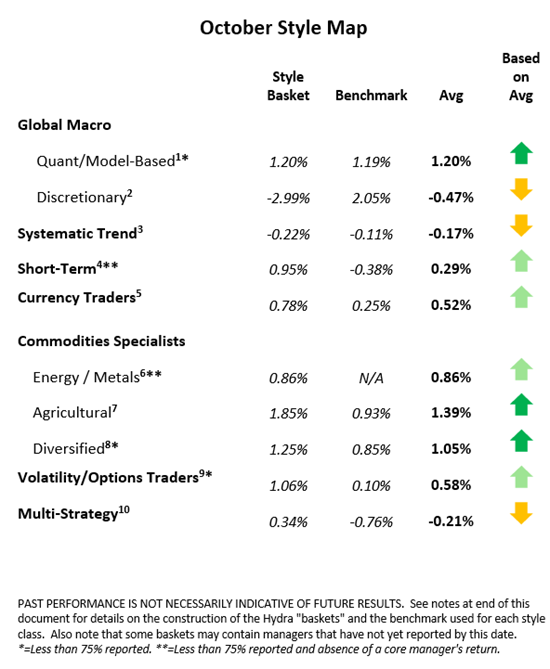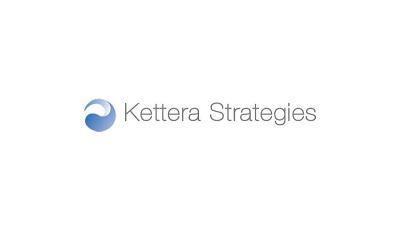Kettera Strategies Heat Map - October 2022
Systematic Trend Managers
Most systematic trend programs suffered some degree of setback in October in the equity index markets, due to short positions carried over from late September. However, short fixed income and interest rate positions generated profits once again. In the currency sector, which has been one of the more lucrative over the last year, short JPY (against nearly all other currencies) appeared to be a winning stance for most programs, with short JPYISD being the most prominent. Performance in the commodities markets seemed to be a mixed bag for these programs, most of which saw losses in energies and base metals markets, but gains in gold and grains/soft markets.
Discretionary Global Macro Managers
October was likely a tough month to be a discretionary, fundamental macro manager. Most discretionary programs sustained setbacks across all market sectors - with the possible exception of some commodities markets (save for precious metals, which posed challenges). Not unlike systematic trend programs above, shorting equities and equities indices was a popular a position for most programs. But the bigger story is what may lie ahead. Discretionary managers are becoming divided over the effects of inflation – is the fear overblown and it’s now time to become a contrarian (e.g. go long bonds and short the USD)? Getting this picture right is what will determine the next few months’ returns.
Quantitative Macro Managers
For many, if not most, of the quant macro programs we cover, commodities markets appeared to be the most fertile ground in October. And, in contrast to systematic trend and discretionary macro traders, managers in this category tended to be long equities, which made it a net winner for most programs. But commodities were the best performing sector, particularly positions in the energy and agricultural markets. Bonds and interest rates were the most unprofitable sector.
Commodities-Only Programs - Diversified Multi-Sector
A newer style category, diversified commodities programs are portfolios that cover all commodities and natural resources markets. In October, most of the diversified programs we follow were positive. Short precious and base metals positions were profitable as prices in both were once again under pressure throughout the month. Fundamentally-based metals specialists, being mostly long, ended the month with slightly negative performance. Energy was positive primarily from long positions in crude and short positioning in natural gas (directional and short spread bias), with some mixed trading in petroleum products such as gasoil and heating oil. Grains trading was also positive for most diversified commodities programs, primarily from long corn and soybean complex (beans, oil, meal) positions, although trading ranges were tight. The soft commodities sector of these diversified portfolios was positive if the program was short cotton or coffee during the month.
Commodities-Only Programs – Agricultural Specialists
The agricultural markets settled down considerably in October. Corn and soybean futures were particularly calm, with corn volatility falling to a two-year low, and soybean volatility to a one-year low. The markets rewarded holders of long (and net long) positions in corn and soybeans/soymeal/soybean oil, whether directional or using spreads. In livestock markets, cash cattle prices surged higher in October, supported by strong beef demand and accompanied by higher-than-expected harvest (slaughter) rates. Long positioning was profitable. Those ag specialists that traded the softs largely did so unsuccessfully – particularly if long coffee and/or cotton, both of which sold off steadily throughout the month due to macro events and against micro-fundamental considerations.

**********
For the “style classes” and “baskets” presented in this letter: The “style baskets” referenced above were created by Kettera for research purposes to track the category and are classifications drawn by Kettera Strategies in their review of programs on and for the Hydra Platform. The arrows represent the style basket’s overall performance for the month (e.g. the sideways arrow indicates that the basket was largely flat overall, a solid red down arrow indicates the basket (on average) was largely negative compared to most months, etc.). The “style basket” for a class is created from monthly returns (net of fees) of programs that are either: programs currently or formerly on Hydra; or under review with an expectation of being added to Hydra. The weighting of a program in a basket depends upon into which of these three groups the program falls. Style baskets are not investible products or index products being offered to investors. They are meant purely for analysis and comparison purposes. These also were not created to stimulate interest in any underlying or associated program. Nonetheless, as these research tools may be regarded to be “hypothetical” combinations of managers, hypothetical performance results have many inherent limitations, some of which are described below. No representation is being made that any product or account will achieve profits or losses similar to those shown. In fact, there are frequently sharp differences between hypothetical performance results and the actual results subsequently achieved by any particular trading program. One of the limitations of hypothetical results is that they are generally prepared with the benefit of hindsight. In addition, hypothetical trading does not involve financial risk, and no hypothetical trading record can completely account for the impact of financial risk in actual trading. There are numerous other factors related to the markets in general or to the implementation of any specific trading program which cannot be fully accounted for in the preparation of hypothetical performance results and all of which can adversely affect actual trading results.
Benchmark sources:
1- Blend of Hedge Fund Intelligence Global Macro Index and Eurekahedge Macro Hedge Fund Index
2- The Hedge Fund Intelligence Global Macro Beta Index: (same link as above)
3- The Societe Generale Trend Index
4- The Societe Generale Short-term Traders Index: (same link as above)
5- The Eurekahedge AI Hedge Fund Index
6- The Barclay Hedge Currency Traders Index
7- Blend of Barclay Discretionary Traders Index and Bridge Alternatives Commodity Hedge Fund Index
8- The Barclay Agricultural Traders Index: (same link as above)
9- The Barclay Fixed Income Arbitrage Index: (same link as above)
10- Blend of Eurekahedge Relative Value Volatility Hedge Fund Index and Eurekahedge Long Volatility Index
11- Blend of Eurekahedge Asset Weighted Multi Strategy Asset Weighted Index and Barclay Hedge Fund Multi Strategy Index
12- Eurekahedge Event-Driven Hedge Fund Index
13- The Barclay Hedge Crypto Traders Index
Indices and other financial benchmarks shown are provided for illustrative purposes only, are unmanaged, reflect reinvestment of income and dividends and do not reflect the impact of advisory fees. Index data is reported as of date of publication and may be a month-to-date estimate if all underlying components have not yet reported. The index providers may update their reported performance from time to time. Kettera disclaims any obligation to verify these numbers or to update or revise the performance numbers.
***
The views expressed in this article are those of the author and do not necessarily reflect the views of AlphaWeek or its publisher, The Sortino Group
© The Sortino Group Ltd
All Rights Reserved. No part of this publication may be reproduced, stored in a retrieval system or transmitted in any form or by any means, electronic, mechanical, photocopying, recording or scanning or otherwise, except under the terms of the Copyright, Designs and Patents Act 1988 or under the terms of a licence issued by the Copyright Licensing Agency or other Reprographic Rights Organisation, without the written permission of the publisher. For more information about reprints from AlphaWeek, click here.







